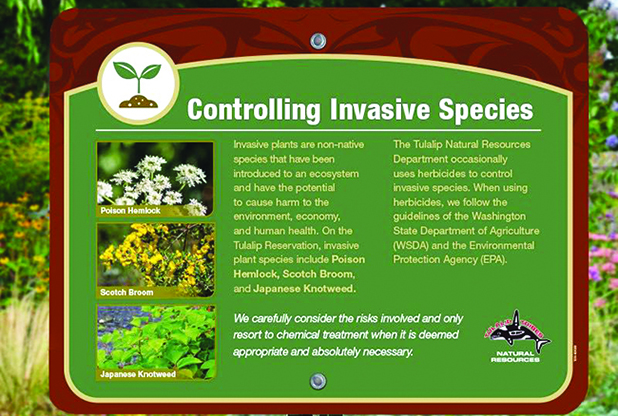
By Niki Cleary, Tulalip News
Colonization is named the root of numerous ills in Native America. We often forget that while our people and culture suffered the effects of colonization by other humans, our lands were also colonized by non-native plants. Some are easily managed, and others have been wildly out of control since nearly the day they were introduced.
On the Tulalip Reservation, Poison Hemlock, Scotch Broom, and Japanese Knotweed are some of the most pervasive. The problem isn’t that non-native species are inherently bad. In fact, many beneficial food crops are non-native. The most obvious problem is that invasive species outcompete native species that provide food and shelter for native animals.
Austin Richard, a Stewardship Ecologist with Tulalip’s Natural and Cultural Resources Division, is part of the team working to decolonize habitats on the Reservation.
“Part of my job entails invasive plant management and treatment both on Reservation and throughout our usual and accustomed areas,” he explained. “We define invasive species as plants or animals that do not naturally occur in an ecosystem and whose introduction can cause environmental harm, economic harm, or harm to human health.”
The on-Reservation efforts focus on areas where people work or play regularly. The Betty J. Taylor Early Learning Academy, the Gathering Hall, and the Health Clinic waterfront. Austin described the three primary species his team is targeting.
Poison Hemlock, as its name implies, is toxic to people and animals. “We want to make sure it’s not accidentally ingested or harming people,” said Austin.
According to the USDA*:
Poison Hemlock can poison animals who eat the plant, either fresh or dried.
It looks very similar to wild parsnip, which is edible.
Children have been poisoned and died from using the hollow stems as homemade whistles.
Signs of Poison Hemlock exposure include trembling, ataxia (poor muscle control) that affects the lower or hind limbs, salivation, lack of coordination, dilation of the pupils, rapid, weak pulse, respiratory paralysis, coma, death, convulsions and occasionally bloody feces and gastrointestinal irritation.
Scotch Broom is next on the list. Whether they know it or not, most people have seen Scotch Broom growing alongside the freeway. According to the National Parks Service** it is a member of the pea family. This ornamental was introduced to North America from Africa and parts of Europe. It was also used as erosion control along highways. Its bright yellow flowers are in full brilliant display currently. When the plant is pollinated, it produces pods that dry and twist until they burst, flinging thousands of seeds into the surrounding area.
“The major problem with Scotch Broom is how rapidly it spreads,” said Austin. “It out shades and outcompetes native plants so that nothing else can get established. It’s really difficult to control because those seed pods explode and release tens of thousands of seeds. Those seeds can last upwards of 60 years in the soil. So even if you kill the plant initially, if you’re not reintroducing native plants in the soil, the seeds can propagate, and you have more Scotch Broom plants.”
Japanese Knotweed is the third target species. Another escaped ornamental, Japanese Knotweed can grow up to 8 feet tall, spread by seed, tiny plant fragments, and its extensive root system. Sometimes incorrectly referred to as bamboo, *** Japanese Knotweed has reddish brown hollow stems, large leaves, and whitish flowers that grow in clusters. Although it seems like a pretty landscape plant, it can cause some real damage to infrastructure and the environment.
“Salmon need really specific habitat and conditions,” described Austin. “They need cooler water temperatures and specific gravel types, not too small like sand and silts because that will suffocate their eggs, but not so large that the salmon can’t move them to create the redds (nests) where they lay their eggs. The problem with Knotweed is that it doesn’t allow those conifers to grow and provide shade to the streams.
Lack of large conifers also impacts the way streams flow, said Austin, “Those large conifers grow and then fall into the water, providing larger woody debris and creating pooling, and more habitat complexity that salmon and smaller fish rely on. Knotweed also grows extensive root systems that spread out – but don’t stabilize the soils. That allows the banks to become eroded and provide more silt and sand that covers up spawning gravel and suffocates salmon eggs.”
Knowing the damage they do, it still begs the question, why pesticides? Can’t we rip them out and call it good? It’s not that easy, said Austin. Each plant requires a specific chemical treatment administered within a particular time frame to be effective. The team always weighs the benefits and risks before resorting to chemical interventions.
“We use manual and mechanical means whenever possible unfortunately, some of those natural vinegar-type treatments just don’t work,” said Austin. When used according to the regulatory guidelines and labels, the products we use are very safe for humans and animals. Once they’re sprayed, and the product dries, there is minimal risk to humans and animals.”
Signage is posted indicating the day and time the area was treated to protect and educate people.
“We recommend people avoid the area for 24-48 hours to allow the herbicides to dry on the plants and reduce any impacts. The chemicals we use are all approved for aquatic use by the EPA and Washington State Department of Agriculture.”
If you want to know more or have noxious weeds from your property, contact Austin at 360-716-4603, or email arichard@tulaliptribes-nsn.gov.
- *Source: https://www.ars.usda.gov/pacific-west-area/logan-ut/poisonous-plant-research/docs/poison-hemlock-conium-maculatum/
- ** Source: https://www.nps.gov/articles/scotch-broom.htm#:~:text=Native%20to%20northern%20Africa%20and,along%20highway%20cuts%20and%20fills.
- *** Source: https://invasivespecies.wa.gov/priorityspecies/japanese-knotweed/